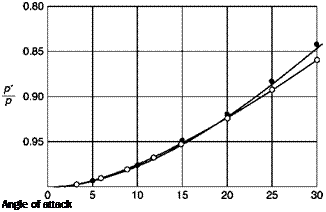Effects of the position of pressure taps
The measured pressure is appreciably influenced by the position of the taps with respect to the head and to the stem (Figure 2.13): downstream of the head an increase in speed will be generated with a consequent decrease in pressure, the presence of the stem introduces an error of the opposite sign. The position of the orifices should be chosen such that the error due to the presence of the head is approximately equal and opposite of that due to the stem. Using this technique, Prandtl made a very compact probe (Figure 2.12) where the taps were located at 2.9 D from the head (error = -1%), and 9.6 D from the stem (error = 1%). In a more reliable probe, built at NPL, the taps are positioned at 8 D from the head (error = – 0.5%) and 16 D from the stem (error = 0.5%).
2.4.1 Effects of non-alignment
If the static probe is not aligned with the direction of the velocity, there is a distortion of streamlines, or even separation with consequent
 |
Errors in static pressure due to the position of taps

 |
Influence of the angle of attack on the readings of a static probe
pressure changes. The influence of angle of attack on the reading of the static tube, as shown in Figure 2.14, is larger than that for the Pitot tube (Figure 2.4). To reduce the effects of the angle of attack, from 4 to 8 orifices are drilled, depending on the pipe diameter, distributed on a circle: the presence of several orifices causing flows inside the tube tends to average in some way the values read by the various orifices.











